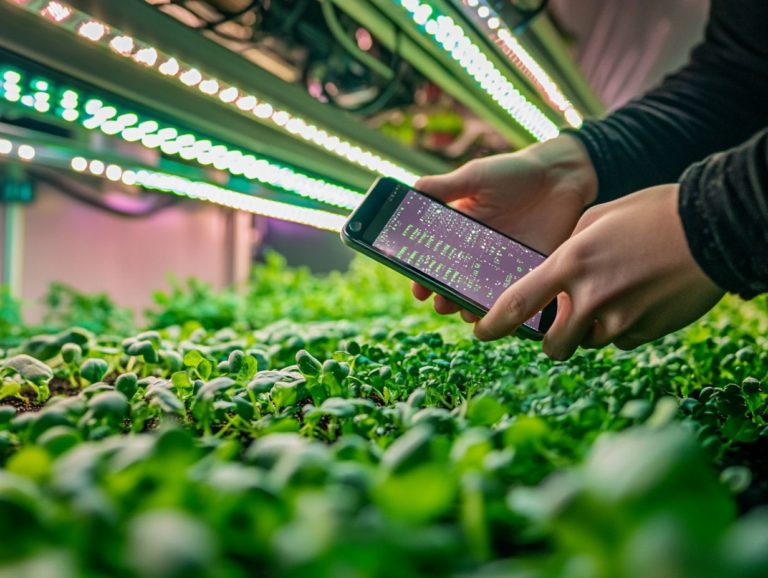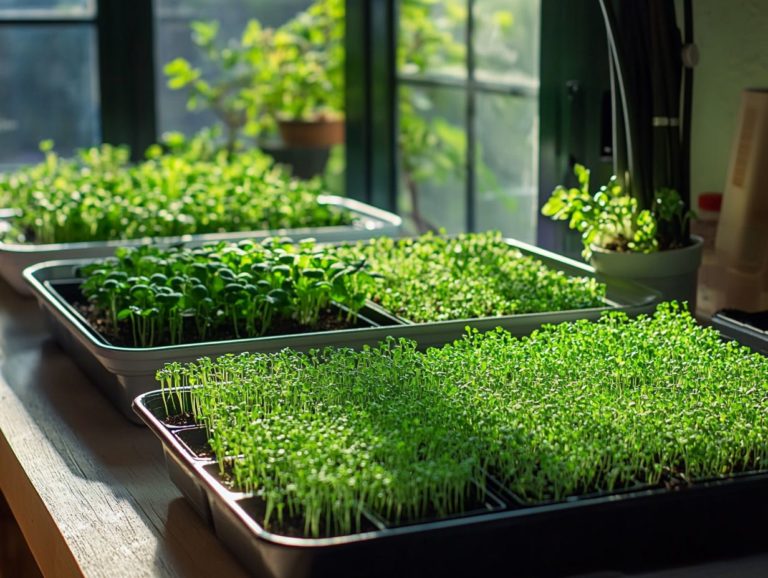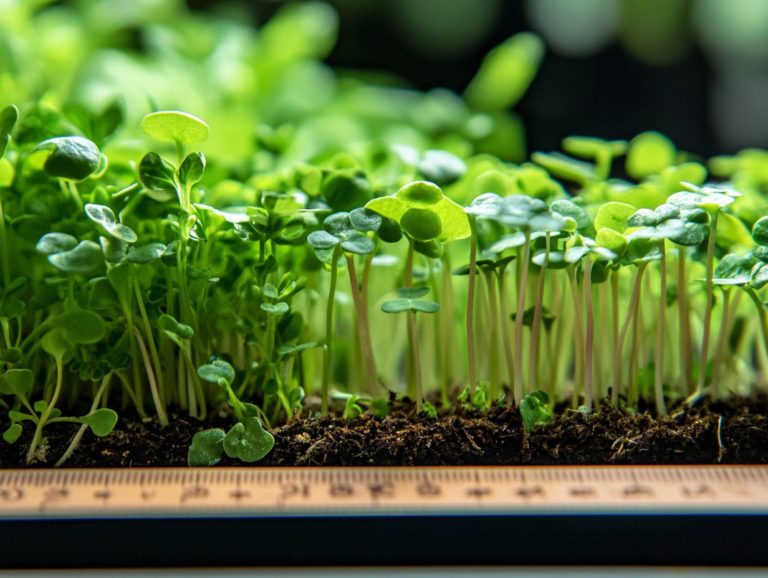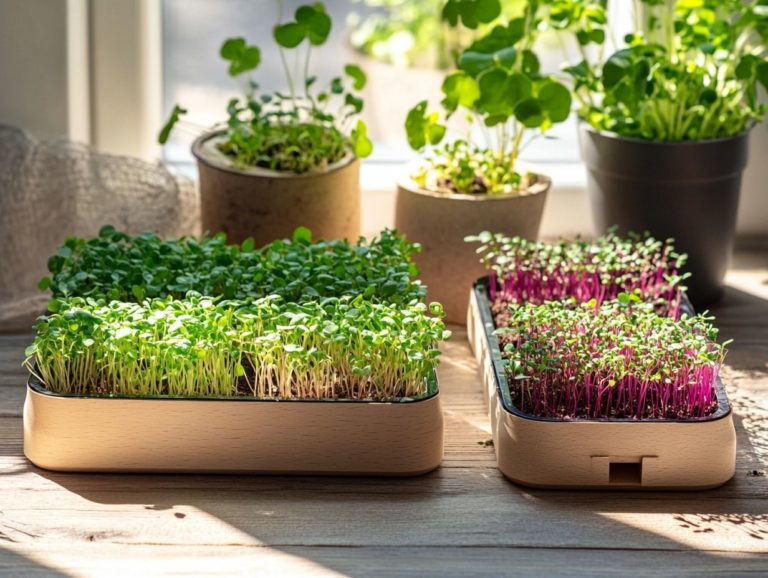How to Start a Microgreen Supply Business
Microgreens are small, nutrient-dense plants that bring a burst of flavor and a multitude of health benefits to your dishes.
As the demand for fresh, locally sourced produce grows, launching a microgreen supply business offers an enticing prospect for aspiring entrepreneurs like you.
This guide will walk you through the essentials of starting your venture, from grasping market trends and profit potential to practical steps for cultivating, marketing, and selling your microgreens.
Whether you have a green thumb or sharp business acumen, diving into the microgreen industry could be your next remarkable opportunity!
Contents
- Key Takeaways:
- Benefits of Starting a Microgreen Supply Business
- Steps to Starting a Microgreen Supply Business
- 3. Growing and Harvesting Microgreens
- 4. Marketing and Selling Your Product
- Tips for Success in the Microgreen Industry
- Maximizing Yield and Quality
- Frequently Asked Questions
- What is a microgreen supply business?
- What are the benefits of starting a microgreen supply business?
- How do I get started with a microgreen supply business?
- Do I need any special equipment or space to start a microgreen supply business?
- How do I market and sell my microgreens?
- Do I need any special knowledge or experience to start a microgreen supply business?
Key Takeaways:

- There is high demand and profit potential for microgreens in the market, making it a lucrative business opportunity. The microgreens market is growing fast, offering aspiring business owners a unique chance to thrive.
- Proper research, planning, and acquiring necessary materials and equipment are essential steps to starting a successful microgreen supply business.
- Maximizing yield and quality, as well as building a strong customer base, are key factors for success in the microgreen industry. Understanding growing techniques is also important.
What are Microgreens?
Microgreens are young, edible plants harvested after the first true leaves appear. They are full of flavor and nutrients, making them a favorite among health-conscious people.
Popular varieties include Red Amaranth, Red Cabbage, Kogane, and Purple Basil. These colorful superfoods not only add taste but also brighten up your dishes, making them sought-after by local restaurants and discerning customers.
These tiny greens are packed with vitamins A, C, and K, along with antioxidants that combat oxidative stress. Chefs love using microgreens in salads, sandwiches, and as garnishes, giving traditional recipes a fresh twist.
For example, Arugula microgreens add a peppery punch, while Pea Shoots bring a touch of sweetness to various dishes.
Growing microgreens indoors is easy, making them popular with home gardeners. They can enhance everyday meals with minimal effort.
Benefits of Starting a Microgreen Supply Business
Starting a microgreen supply business presents you with a wealth of opportunities, especially if you’re passionate about sustainable agriculture and health. The microgreens market has experienced remarkable growth, driven by rising local demand from health-conscious consumers and restaurants eager for fresh, high-quality ingredients.
By immersing yourself in this burgeoning trend and aligning with community-supported agriculture (CSA) models, you can cultivate a successful and impactful business that resonates with your values and the needs of your microgreens community. Community-supported agriculture models involve consumers buying shares of a farm s harvest in advance, ensuring fresh produce for them while supporting local farmers.
Get excited about the potential this venture brings!
Market Demand and Profit Potential
The microgreens market is experiencing a remarkable expansion, driven by the rising demand from health-conscious individuals and restaurants eager to elevate their menus with fresh superfoods. This surge presents a lucrative opportunity for microgreens businesses to cater to the distinctive tastes of the community, showcasing an impressive variety of nutritious plant selections that resonate with a diverse clientele.
Recent studies reveal that the microgreens sector is projected to grow at an impressive compound annual growth rate of around 20% over the next five years, highlighting significant interest from both individual consumers and culinary establishments. Many top-rated restaurants now use locally sourced microgreens. This adds vibrant flavors and nutritional benefits, attracting patrons who seek farm-to-table experiences.
Social media influencers are also documenting their culinary journeys, emphasizing the aesthetic appeal and health advantages of microgreens, which further ignites consumer curiosity and demand. These trends underscore a shift toward sustainable eating and a preference for unique, flavorful ingredients, making microgreens an enticing choice for today s discerning consumers.
Steps to Starting a Microgreen Supply Business
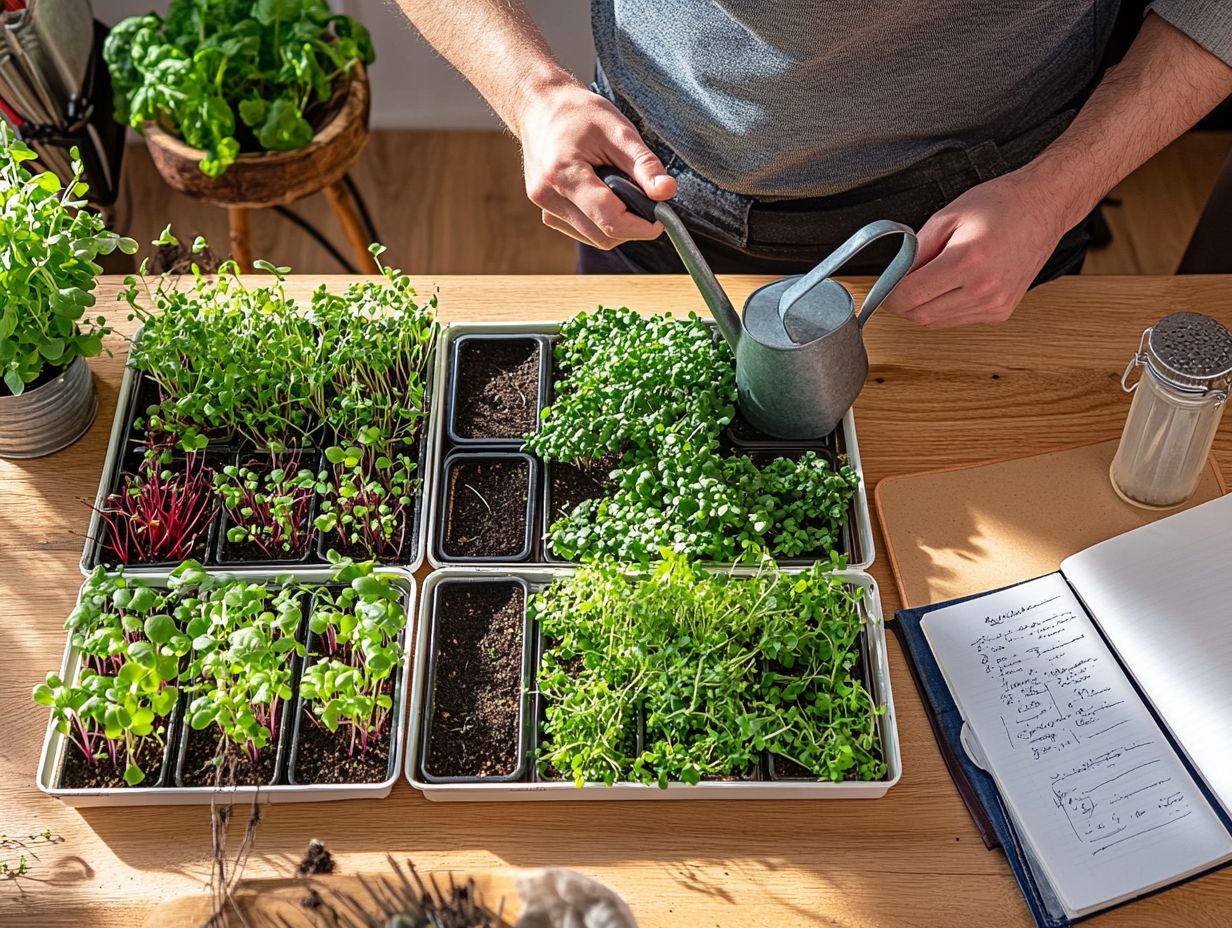
Get ready to dive into the exciting journey of starting your microgreens business! First, understand the essential steps to succeed. You ll want to start with thorough market research to identify opportunities and select high-quality equipment that will facilitate optimal growth.
Remember, cultivating microgreens goes beyond the initial setup; it requires dedication and patience to refine your growing techniques and to nurture meaningful relationships within your local community.
1. Research and Planning
Research and planning form the backbone of successfully launching your microgreens business, as they provide crucial insights into local demand and community preferences.
By employing various methodologies, such as surveys and interviews, you can gather essential information about consumer habits and tastes.
Tapping into data sources like market reports and social media trends will further enrich your understanding of what the community values. This comprehensive analysis gives you the power to tailor your product offerings, ensuring they not only meet customer needs but also resonate with local farming initiatives.
Aligning your microgreens with local culinary trends and highlighting their health benefits will enhance brand loyalty and promote sustainability. This cultivates a thriving local ecosystem around your business. Utilizing local farmers markets can also bolster your presence.
2. Acquiring Necessary Materials and Equipment
Acquiring the right materials and equipment is absolutely crucial for growing microgreens efficiently and effectively. You’ll want to ensure you have high-quality seeds and tools that complement your chosen growing techniques. Investing in affordable gardening solutions can optimize your setup, allowing you to produce fresh microgreens that appeal to your target market.
The fundamental components you need include seed trays, a suitable growing medium, and adequate lighting—all essential for creating a thriving microgreen environment. For those interested in starting, a step-by-step guide to sowing microgreens can be incredibly helpful. It’s vital to select trays made from durable materials that can handle moisture while providing proper drainage.
In terms of the growing medium, whether you choose soil or coconut coir, it should be nutrient-rich yet lightweight to support rapid growth. Appropriate grow lights can significantly affect your yield, so understanding the light spectrum necessary for photosynthesis is key.
By carefully selecting these materials, you’ll ensure that your costs align with overall quality and efficiency, setting the stage for a successful microgreens venture.
Start your microgreens adventure today, and join the growing trend of fresh, healthy eating!
3. Growing and Harvesting Microgreens
Growing and harvesting microgreens requires careful attention to detail and a good understanding of different plant types. Dedication and patience are essential to achieve high yields and quality.
Consider exploring innovative methods like hydroponic systems, which involve growing plants in water without soil, or traditional soil-based cultivation. Each method has unique advantages, and using controlled watering, consistent light exposure, and organic fertilizers can enhance growth rates and flavor.
Observe your microgreens closely to harvest at the right time. This is crucial for maximizing their nutritional value.
Maintaining a clean environment and using sanitized tools prevents contamination. These practices boost productivity and help you build a reputation for quality.
4. Marketing and Selling Your Product

Effectively marketing and selling your microgreens is vital for your business success. Building strong relationships with restaurant clients and the local community is key.
Utilize community-supported agriculture models to connect with health-conscious consumers eager for fresh produce. Engage potential customers by highlighting the impressive nutritional value and culinary versatility of microgreens.
Participate in local farmers’ markets or food festivals. This showcases the freshness of your product and strengthens community ties.
Collaborate with chefs to create signature dishes featuring microgreens. Use social media to share recipes and educational content, reaching a broader audience.
This approach boosts customer loyalty and positions your brand prominently in the local food scene.
Tips for Success in the Microgreen Industry
Success in the microgreen industry requires a solid strategy focused on quality control and responsiveness to local demand. Engaging with the microgreens community is equally vital.
Adopt best practices and consistently provide high-quality products. This will help you cultivate a loyal customer base and a respected reputation.
Maximizing Yield and Quality
Maximizing yield and quality is essential for meeting customer expectations and ensuring long-term success. Use effective growing techniques and robust quality control measures to enhance both quantity and quality.
Experiment with different growing mediums and lighting conditions tailored to your microgreens. Regularly monitor temperature and humidity to create an optimal growing environment.
Employing organic fertilizers elevates nutrient levels, leading to healthier plants. Implement systematic harvesting and handling to maintain freshness.
Using proper storage methods keeps microgreens vibrant and crisp. This attracts loyal customers who appreciate premium products.
Building a Strong Customer Base
Building a strong customer base is essential for the sustainability of your microgreens business, especially when you’re targeting local restaurants and health-conscious consumers. Engaging with local farming programs allows you to forge meaningful connections and cultivate loyalty, positioning your business as a trusted provider of fresh microgreens.
To effectively nurture this customer base, implementing ways to build strong customer relationships is key to fostering loyalty. Actively participating in local events and farmers’ markets not only boosts your visibility but also showcases your commitment to the community.
Customer feedback can be a game-changer for your business! Seeking and incorporating it can significantly enhance your product offerings, ensuring they resonate with consumer preferences. Establishing a robust social media presence allows you to engage potential clients directly, facilitating conversations and interactions that deepen connections.
By inviting customers to share their experiences and ideas, you can tailor your approach, ultimately crafting a more personalized experience that appeals to those who prioritize quality and sustainability.
Frequently Asked Questions

What is a microgreen supply business?
A microgreen supply business involves growing and selling small, nutrient-dense plants that are harvested just after they have sprouted their first set of leaves. These microgreens are often used in salads, sandwiches, and as a garnish in dishes.
What are the benefits of starting a microgreen supply business?
Starting a microgreen supply business can have several benefits, including low startup costs, high demand for healthy and fresh produce, the ability to grow year-round, and a quick growing cycle of just 1-2 weeks. You can also explore local events and farmers’ markets to increase visibility and sales, making it an appealing option for entrepreneurs interested in microgreens.
How do I get started with a microgreen supply business?
The first step to starting a microgreen supply business is to research and familiarize yourself with the market and demand in your area. Decide on the types of microgreens you want to grow and then acquire the necessary supplies, such as seeds, growing medium, trays, and light sources.
Do I need any special equipment or space to start a microgreen supply business?
You do not need a lot of space or specialized equipment to start a microgreen supply business. You can grow microgreens in small trays or containers in a space as small as a windowsill. You will need a light source, such as a grow light, to ensure your microgreens receive enough light for optimal growth. Exploring options like FLIP Insurance can also provide peace of mind as you dive into this business, especially when experimenting with different varieties.
How do I market and sell my microgreens?
Find people who might buy your microgreens. These include health food stores, restaurants, farmers’ markets, and individuals interested in fresh produce.
Develop a marketing strategy. Create a website or social media presence and reach out to promote your microgreens.
Offering free samples can attract new customers.
Do I need any special knowledge or experience to start a microgreen supply business?
No special knowledge is needed to start a microgreen supply business. However, understanding plant growth is beneficial.
Researching different microgreens can also help. Consider attending workshops to learn growing techniques.

